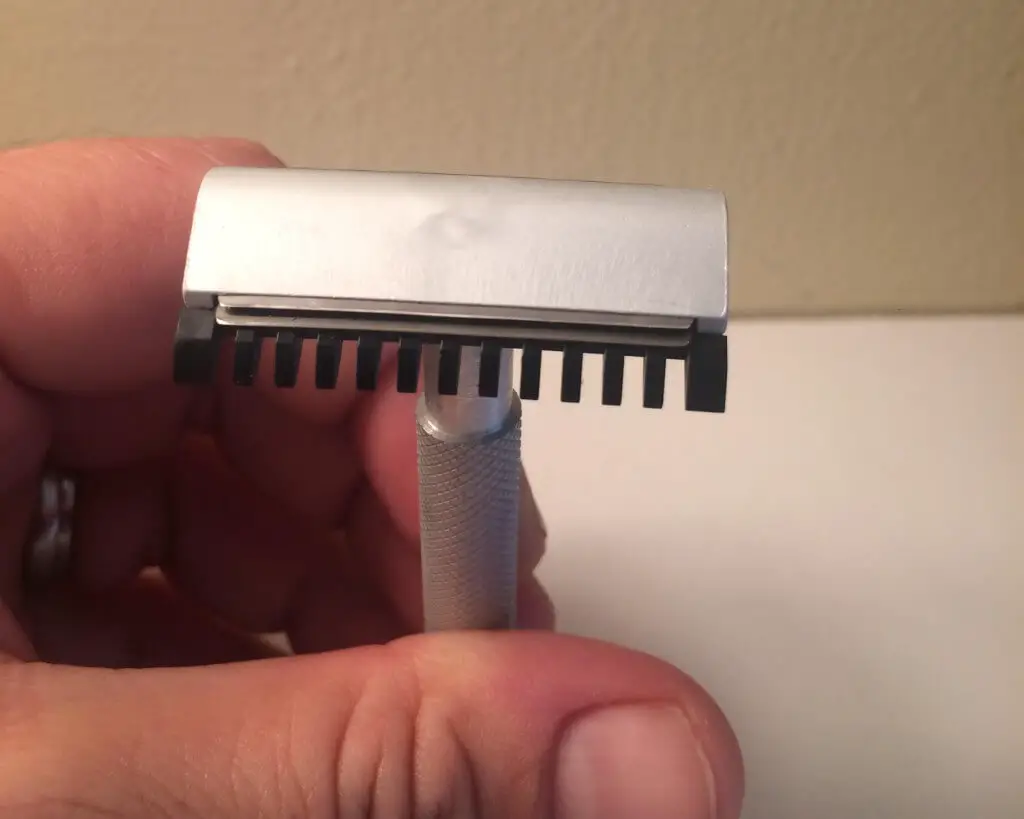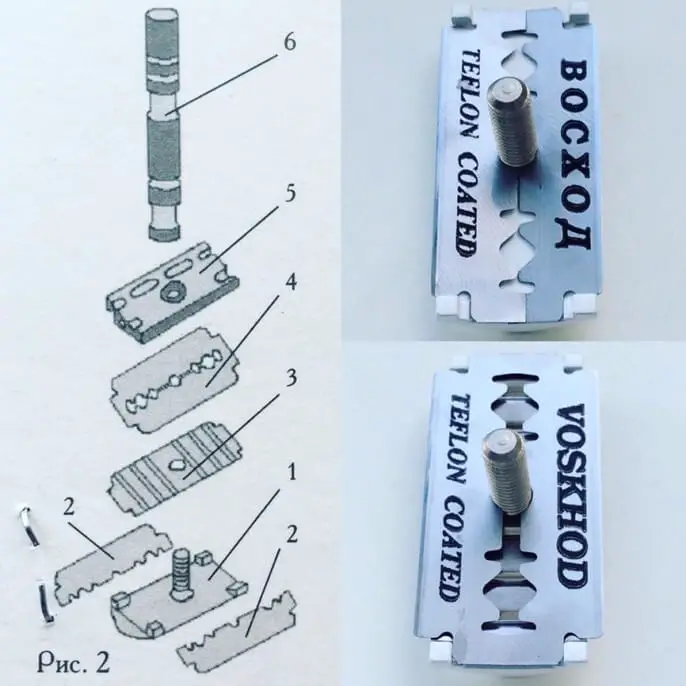
[Note from Mantic59: This razor is no longer available. This article will remain for archival/buy/sell/trade purposes.] Traditional wet shaving is always full of surprises. Once you think you’ve seen it all, something else emerges from the deep and really throws a curve ball. It’s funny in a sense that a traditional process that has been used for decades, goes obsolete and then reemerges with new concepts and products. Recently I discovered the Saiver Profimed 2.0 which utilizes a twin blade design in a good old fashioned traditional safety razor.
At first, this concept baffled me, as most traditional wet shavers are subject to use one blade in their shaving process and generally avoid multi-blade style razors that have become ever so popular with today’s society. Intrigued, I decided to try this razor without any skepticism even though in the back of my mind I had second thoughts. I wanted to give this razor a fair shot. I’m very glad I did.

The Saiver Profimed 2.0 razor is designed to hold two double edge safety razor blades aligned just so the bottom blade makes the first cut and the top blade makes the second. The concept is similar to that of a Gillette Trac II, with a few differences. First, you load your own blades rather than just clipping on a blade loaded cartridge. Second, there is more gap in between the blades, giving the user more control of the angle when shaving.
Composition:
The Savier 2.0 is manufactured by the Kontakt Company out of Yoshkar -Ola in the Mari Republic of Russia. It is one of two razors Kontakt produces in the dual blade design with the other model being a 6-piece travel set complete with a case and solid guard bar.
The Savier 2.0 is composed of 4 parts (handle, top cap, shim plate and guard) of several different materials. The handle is made of duralumin, which is a hard aluminum alloy that has traces of copper and magnesium in it composition. This form of aluminum was discovered in 1906 by Alfred Wilm and later patented in 1909 for the Dürener Metallwerke Company for use in aircrafts. Duralumin can be compared to a soft steel but seems to be durable enough for razors.
The top cap of the razor is made of a painted silumin another form of aluminum that is very strong and has a high resistance to corrosion. This metal is primarily used in cast aluminum cookware and is fairly common. The bolt located in the top cap used to connect the handle to the rest of the razor is made of a basic steel as well as the shim plate that’s used to line up the blades.
The blade guard is composed of plastic that is strong enough for shaving use. The guard features a solid guard bar on one side and an open comb bar on the other. This gives the user some variety when shaving.
At 27 grams The Savier 2.0 is one of lightest razors I have ever handled. Even though it’s extremely light it’s relatively strong and durable. The razor is very balanced even loaded with two blades and does feel top heavy.
Loading the Blades:

When I first received this razor, I have to admit I looked at it for minute or two scratching my head. Loading the blades I thought, how in the world am I going to do this? I went to the internet and found one image illustrating how to do so.
Loading the blades does take a minute or two. It’s very important to make sure the blades are even and in the grooves before you tighten down the handle. I’ve tried several different ways to load the blades but found it best way is assemble the razor upside down.
Start with the top cap resting on the towel and then take one DE blade and snap in half while still in the package. Carefully load the blades into the groves of the top cap and make sure the ½ blades sit evenly in between the groves. Next, take the steel plate or shim and place it on top of the blades so that the shim is in a “U” shape. Then, load the second DE blade in one piece on top of the shim and then install the plastic guard. When everything is together take the handle and screw it down holding the rest of the razor so it stays straight. Check your work and you’re all set.
To make the process easier to understand I decided to make a video on loading the blades. It’s a little tricky but with some practice you’ll be a pro in no time at all.
Review:

I was very skeptical when I first picked up this razor. The twin-blade design had me thinking about the days I used cartridge razors and the reasons why I converted to traditional wet shaving. After some hesitation I jumped right in.
Shaving with the grain quickly reminds you how light the razor is. Too much pressure and this razor will let you know you’re doing it all wrong. It will cut too close which will result in irritation. I experimented slightly and came to the conclusion that just letting the razor touch your skin was enough for me. I didn’t consider the ultra-light weight a draw back on the performance just on preference. All this razor needs is a guide, it will take care of the rest.
In my experience each razor has its own “sweet spot” or perfect angle and pressure combination which the razor works optimally. This can take longer to learn on certain razors but with this one I found it quite easily. The top cap of the razor is angled in a way to help you. I found that leading the shaving stroke with the angle of the “top” blade provided the best results. An extremely clean shave, with zero irritation or “weepers” (shaving cuts). The WTG (with the grain) pass removed about 90% of my stubble and I could easily get by without a second pass.
I was very impressed with the gap and exposure in between the blades. From the looks of it, the razor appears aggressive but the greater blade exposure (amount of blade shown) and blade gap (amount of space between the blade and guard) line up in such a way it gives the user more control on the angle of approach. This is not possible with modern day cartridge style razors as the gaps are designed to be used at any angle rather than the “perfect angle”.
I decided to go with a two-pass shave rather than a traditional three-pass as this razor did such a good job on the first one. Shaving ATG (against the grain) required the same approach. The lightest pressure possible and to lead with the top blade (which in this pass is the bottom). The razor performed flawlessly and my face was extremely soft. I used this razor for about a month straight and suffered from zero nicks and irritation.
It’s important to mention that it is very important to use this razor with sharp blades. I averaged about 3 shaves per blade and used a multitude of different types. It could be just me but this razor seemed to dull blades quicker than standard DE razors.
Since this razor is different than most DE razors, I made a video shaving with the Saiver 2.0. Check it out here.
Conclusion:
The Saiver Profimed 2.0 is a solid razor for both the beginner and pro alike. It provides an ultra-comfortable shave and is easy to operate with little or no learning curve. It’s a perfect “stepping stone” for those who are making the jump from modern day cartridge style razors to more traditional methods.
While this razor was very impressive in performance it lacks the weight of the average safety razor which may be a drawback to those who favor heavier pieces. It also requires a sharp set of blades (and two at a time) so blade changes will be more frequent.
All in all, this is a great razor at a great price!
About the Author:
Joe Borrelli is a long-time wet shaving enthusiast and collector. He hosts the Wet Shaving News/Talk Podcast , runs his own self-funded website http://shavestraightandsafe.com/ and operates a YouTube channel to help inform the community of new information involving the wet shaving world. Joe holds a BBA from Florida Atlantic University, and currently works for the nation’s largest wine/spirits/beer retailer. In his spare time, he enjoys traveling with his wife Linda, reading, writing, outdoor activities and collecting wet shaving apparel. Find out more about Joe here.

It works well as a Single Blade DE when you load only one blade between the shim and and the base plate.
More gimiks to sell shave gear. When does it end.
Too many people trying to reinvent the wheel. This razor flies in the face of the “one blade is all you need” philosophy and doubles the blade cost.
What’s the next big revelation? Finding a way to stick these two blades into an easy to load cartridge?
Thanks but no thanks.
Why does the top blade need to be snapped in half? It appears that the top blade could be inserted whole. I must be missing something. Please reply.
That’s a great question, Craig. It looks like an entire blade should slip over the bolt and fit nicely into the grooves. But perhaps, that’s the rub. Assuming an entire blade does not fit properly, how hard would it have been to engineer it so it did?
Either way, unless you are desperate to get a good shave (and all the traditional options have failed) or are simply a shaving geek who HAS to try everything (and I appreciate those who do, so we don’t have to), why in the world would someone choose to go through this?
Hi Craig,
Thanks for the comment.
I too thought the top blade could be inserted whole until I tried it. For some reason the blade didn’t meet the correct exposure and would not angle properly . When the blade is snapped in half it fits in just right so the angle of the cutting edge just over the bottom blade. The blade slips into the guard rather rather than just being pressed into it.
Good review, but I say no thanks to this system design! For me, some key benefits of the DE (vs cartridge) shaving system are simplicity of blades, much lower blade price, and single blade edge dragging across your skin. So I see no sense in complicating the DE system by requiring me to break a blade each time I (more frequently?) have to change them, going through blades twice as fast (2 per change), and worst of all, returning to a system that is very likely to cause more irritation due to dusl blade edges.
I’m sure the system works OK. The question really would seem to be, does it sork SO much better than a single blade system? Do you get a significantly closer shave? If not, why pay more, increase blade change time, and inrease chance of skin irritation?
I’ll stick with single blade DEs, thank you!
why not : to 5 blades. I pass.
How does it deal with a few days worth of growth? If it’s finicky to set up I’d imagine it might be a pain if you had to loosen the cap to unclog the blades
Comments are closed.